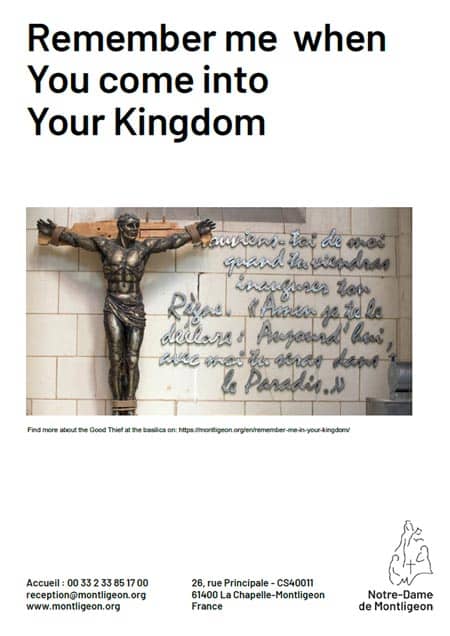Who was the good thief?
The Gospel provides no information about the good thief or the penitent thief, other than that he was a thief, sentenced to death by the Romans and crucified beside Jesus.
“When they came to the place called the Skull, they crucified him and the criminals there, one on his right, the other on his left. (…) Now one of the criminals hanging there reviled Jesus, saying, “Are you not the Messiah? Save yourself and us.” The other, however, rebuking him, said in reply, “Have you no fear of God, for you are subject to the same condemnation? And indeed, we have been condemned justly, for the sentence we received corresponds to our crimes, but this man has done nothing criminal.” Then he said, “Jesus, remember me when you come into your kingdom.” He replied to him, “Amen, I say to you, today you will be with me in Paradise.” (Lk 23, 33. 39-43).
Tradition has it that the callous thief’s name was Gesmas, and the repentent one’s Dismas (which allegedly means “the one who has a heart”).

at the shrine of Montligeon
A model of trust,
a witness to Mercy
During the crucifixion, initially the penitent Thief had joined in with the pharisians and Gesmas in insulting Christ. However, little by little, enlighted by inner grace, he was overwhelmed by the patience of Our Savior; the first words of Christ after the crucifixion had taken place, “Father, forgive them, they know not what they do.”, was like the coup de grace that brought Dismas to this act of faith where he acknowledged Christ as the Son of God.
The penitent thief’s words make manifest the intensity of his repentance, and the depth of his faith: he recognizes the justice of God and demonstrates brotherly charity in encouraging Gesmas to accept their just fate, he emulates the Savior in patiently upholding suffering, and raises a humble and confident prayer to God.
The penitent thief epitomises the right repentance. He loathed his past mischiefs and confess his sin, but also his love for Christ. He sustains the pains of the crucifixion and the turmoil of death. Dismas is the living proof of the might begotten by Christ’s blood, as well as of the infinite mercy of God.
Moreover, he is a model of trust; humbly, full of hope and faith, he prays to the Lord to receive him
in His Kingdom. His prayer makes its way to the Heart of Jesus. Subsequently, he yields Christ’s tender gaze. Thus, the thief reaches to the Father. He became the first ever to be canonized.
Let us entrust our deceased to God’s mercy by saying: “Jesus, remember (Name)…”.
Saint Dismas
nowadays
At the basilica, the Good Thief’s chapel
Both its statue and altar are the works of Michel Laude. They have been offered to the shrine in 2011 by the “ Good Thief” Prison Sodality which associates itself to the prayer of the shrine for the forsaken souls in purgatory. The deceased prisoners are part of it.
About its stained glass-window
depicting Saint Monica
The stained-glass window represents St Monica recommending herself to her son St Augustine’s prayers, as she is about to die. “Bury my body wherever you will; let not care of it cause you any concern. One thing only I ask you, that you remember me at the altar of the Lord wherever you may be.” The prayers of St Monica for her son’s conversion bore fruit beyond her expectations. Converted, he became priest, thence a bishop, St Augustine will from then on intercede for his mother by offering the sacrifice of Mass. By means of offering Mass for her, St Monica’s soul rose to heaven in glory. Family esprit de corps endures beyond death.
Almighty and merciful God,
who makes just the sinners,
we humbly beseech Thee:
by means of your Son’s loving gaze which enticed the good thief,
Motion us to true repentance and grant us the eternal glory that he was ensured.
Through Christ, our Lord.
Amen.


